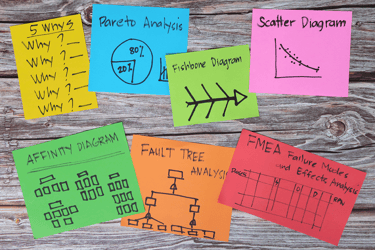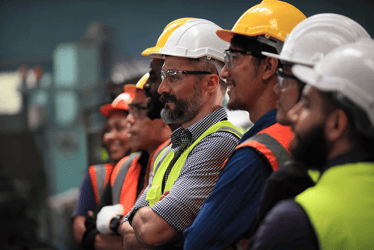The Packaging Industry's Sustainability Challenge: Why ERP Systems Are Essential for Success A straightforward guide to navigating sustainability regulations across folding carton, flexible...
Can You Really Run a Corrugator Without Experience?
With automation evolving rapidly, a common question is echoing across corrugated plants:
Can you run a corrugator without years of hands-on experience?
The short answer is: yes, if the right systems, processes, and people are in place.
It’s not about eliminating expertise. It’s about accelerating it. Modern corrugator control systems, digital guidance, and structured onboarding can equip new operators to run machines safely, confidently, and effectively in a fraction of the time it used to take.
But technology alone isn’t the complete answer. The fundamental shift lies in how plants balance automation with applied knowledge - and how they redesign training for a new generation of operators.
Systems Can Guide, But People Still Matter
Automation today can do a lot:
- Adjust temperature, steam pressure, and wrap arm angle based on paper properties
- Monitor starch viscosity and board moisture in real time
- Recommend setpoint changes based on current environmental conditions
- Detect and alert for anomalies before faults occur
In the past, these responsibilities fell solely to the operator’s judgment. Now, intelligent systems provide a safety net and a second set of eyes.
But what happens when something goes off-script? A roll collapses mid-run. The glue pan overflows. The board exits the hotplate warped despite all readings looking normal.
This is where people still matter.
Automation manages the predictable. Operators handle the unpredictable. A well-trained operator knows:
- When to override or tweak system settings
- How to troubleshoot the root cause of unexpected results
- What to communicate upstream and downstream to prevent further disruption
In short, control systems support decision-making. They don’t replace it.
What You Need Instead of Experience
Let’s be clear: experience is valuable. A seasoned operator brings intuition that can’t always be taught.
But not every plant has the luxury of a fully experienced team, especially as older operators retire and younger generations seek faster progression.
Instead of hoping for experience, design systems, and training that fast-track it.
Here’s what that looks like:
-
Structured Onboarding with Real-World Relevance
Ditch the three-ring binders. Onboarding should simulate real-world issues and guide operators through fault scenarios, material changes, and production restarts.
Use interactive tools, simulators, or digital twins where available. Focus on why things happen, not just what to press.
-
Recipe Libraries and Run Histories
Create and maintain recipe libraries tied to specific board grades, flute types, and paper combinations.
Make these libraries accessible on the machine, and tag them with performance outcomes like “Best for Winter” or “Low Bond Risk.”
These act as launchpads for new operators, reducing the need for trial and error.
-
Super Users and Shift Champions
Designate experienced team members as mentors. Their job?
- Guide newer operators
- Reinforce system best practices
- Interpret performance data in context
- Champion consistent usage of automation features
This helps distribute knowledge and builds trust across the team.
-
Visual Dashboards That Drive Action
Don’t just display data- make it useful.
- Color-coded KPIs for moisture, warp risk, temperature delta
- Guided alerts: “Bond risk high - check liner temp and starch temp.”
- Operator checklists triggered by anomalies
These tools empower operators to act quickly and confidently, even without extensive experience.
Why Fast-Tracking Competency Matters Now
The old model of operator training relied on years of shadowing, repetition, and trial-and-error learning. That worked when retention was high and machines were simpler.
But today:
- Labor markets are tight
- Retention is a challenge
- Corrugators are more complex
- Material costs are higher
- Waste is less acceptable
You don’t have years to train new operators. You need weeks.
Plants that adapt to this reality outperform those that don’t. They:
- Run faster with less waste
- Use automation more effectively
- See fewer unplanned stops
- Build resilience across shifts
This isn’t about cutting corners. It’s about building confidence through understanding, not tenure.
Build Confidence Through Process Understanding
Years on the job don’t always equal capability.
True confidence comes from knowing:
- What’s happening
- Why it’s happening
- What to do next
Give your operators the tools and training that build this clarity. That means:
Process Knowledge
Explain what’s happening under the hood, how steam affects bonding. Why the glue gap matters. What causes a warp at different machine speeds?
Troubleshooting Steps
Document your most common issues and resolutions. Build a visual “If This, Then That” guide at the machine. Make it part of shift training.
Guided System Alerts
Instead of vague alarms, use meaningful prompts.
Example: “Preheater drum slow to recover heat. Check wrap arm contact and paper tension.”
This structured support enables new operators to build experience safely and efficiently.
Common Misconceptions
“You can’t train instinct.”
You can do so by explaining the variables and allowing operators to experiment in low-risk settings. Simulated faults, test runs, and guided restarts all help develop judgment.
“Automation does everything.”
Automation does a lot, but it’s most effective when operators understand what it's doing and why. If not, it gets turned off or ignored.
“Experienced operators will resist structured training.”
Not if it’s designed with their input. Utilize senior staff to assist in developing training content. Let them lead sessions. Recognize them as knowledge keepers.
Future-Proofing Your Workforce
A corrugator doesn’t run on software or steam alone. It runs on people, and people need support, especially in a high-pressure, fast-paced manufacturing environment.
If you want to reduce operator churn, shorten the time to competency, and drive consistent output, invest in:
- Intuitive automation
- Data that’s actionable
- Training that’s engaging
- Teams that coach each other
This is how you create a self-sufficient operation.
Automation Doesn’t Replace Experience - It Accelerates It
Let’s say it plainly:
You can run a corrugator with less experience if you invest in the right infrastructure.
Not just the tech, but the processes and people around it.
- Equip operators with visual, hands-on training
- Support decision-making with contextual data
- Build a culture where asking questions is encouraged and answering them is rewarded.
With that in place, you won’t need every operator to have 20 years under their belt.
They’ll get up to speed faster - and stay engaged longer.
Ready to Go Deeper?
Whether you're looking to reduce waste, increase uptime, or empower your operators, the first step is understanding your process.
- Join one of our live or on-demand webinars to explore best practices in real-world scenarios.
- Or book a corrugator consultation - we’ll review your current setup and highlight key areas for improvement.




